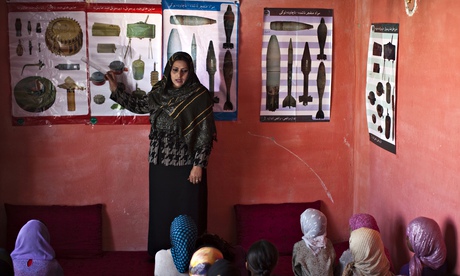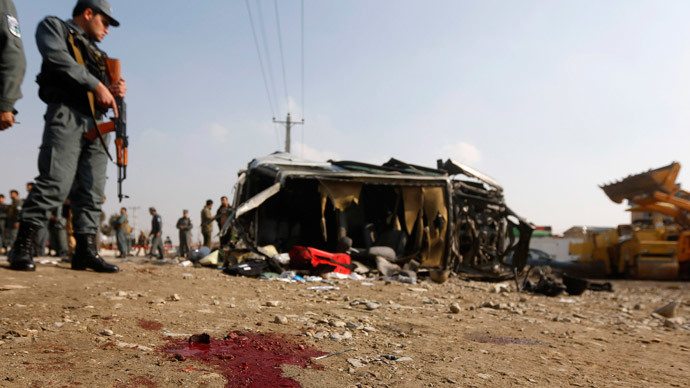International troops pulling out of Afghanistan have left behind a lethal legacy of unexploded bombs and shells that are killing and maiming people at a rate of more than one a day. The vast majority are children.
Bombs dropped from the air coupled with munitions left behind in makeshift firing ranges in rural Afghanistan have made parts of the countryside perilous for locals who are used to working the land for subsistence and raw materials.
Since 2001, the coalition has dropped about 20,000 tonnes of ammunition over Afghanistan. Experts say about 10% of munitions do not detonate: some malfunction, others land on sandy ground. Foreign soldiers have also used valleys, fields and dry riverbeds as firing ranges and left them peppered with undetonated ammunition.

Two of those were 10-year-old Mohammad Yunus and his eight-year-old sister, Sahar Bibi. The grenades that killed Mohammad and Sahar, as they were combing through dry branches to collect firewood for their family, should have detonated long before they were picked up. Instead, the shells exploded in the children's hands and ripped through their bodies, killing them instantly. The blasts also injured their two brothers, aged five and 12.
The four siblings were gathering wood about a kilometre from Camp Clark, a US military base in the eastern province of Khost, in an area used by US soldiers for battlefield training. But the grounds were unmarked, said the children's father, Sheren Totakhail, who didn't realise the danger.
In rural areas, children often bring in vital income to households, but collecting scrap metal or herding animals can be fraught with unpredictable risks. Of all Afghans killed and maimed by unexploded ordnance, 75% are children, according to Macca.
"I wish I hadn't had to ask my children to work, but we are a poor family," said Totakhail. "Now, I don't even allow my other children to go to the bazaar for shopping."
Despite the removal of 16.5m items since mine-clearing programmes were established in 1989 after the Soviet withdrawal, Macca and its predecessors have recorded 22,000 casualties in the same period. Unexploded ordnance still kills and injures about 40 people each month. Since 2010, MACCA has recorded 36 deaths from unexploded ammunition on Nato firing ranges alone. The true number is thought to be much higher.
The withdrawal of western troops presents an opportunity to clean the mess up. At the end of the year, Nato's International Security Assistance Force mission was replaced with a training and assistance under the name Resolute Support, which will see much fewer foreign troops on the battlefields.
Though first steps have been taken to tackle unexploded ordnance (UXO), agencies complain the US-led forces are withholding information about where they may have dropped explosives.
"We ask for information about battlefields that may have UXO, but we have received coordinates for only 300 locations. It's not enough," said Mohammad Sediq Rashid, director of Macca.
Colonel Calvin Hudson, Nato's Combined Joint Task Force chief engineer in Kabul, says Nato gives as much information to mine-clearing agencies as possible without compromising operational security - coordinates for areas where Afghan forces continue their operations are withheld.
Much of the fighting in Afghanistan has taken place in and around residential areas, increasing the risk of civilian casualties in the aftermath of the war. UK and US diplomats emphasise that international law does not give their countries a responsibility to clear battlefields. But that does not absolve Nato countries of their duty to clean up after themselves, said Rashid.
"It is a moral responsibility," he said, adding that scattering unstable explosives around the country defeats the initial purpose of the war. "Military intervention is the last resort, and it's intended to protect people and stabilise the country," he said.
Comment: That is assuming US/NATO have any morals.
According to officials in Afghanistan, western governments became more aware of the risks of unexploded ammunition after a spate of accidents, and subsequent critical media reports, in 2013.
The UK and US governments have since planned a survey with UN agencies to detect and clear explosive remnants of war in Helmand. The US has also allocated $500,000 (£330,000) to survey 19 districts around the country that have seen high military activity over the past 13 years. According to a US embassy spokesperson, there are 185 districts with more than 50 "kinetic engagements".
International forces have been more forthcoming when it comes to cleaning up firing ranges. A diplomat at the British embassy in Kabul says the UK and US are planning to share the cost of clearing six abandoned firing ranges outside Camp Bastion in Helmand.
Of the 240 firing ranges around the country used by Nato, 140 are now controlled by Afghan security forces, and will not be cleared yet, including the range outside Camp Clark. The rest have been slated for clearance.
According to Hudson, cooperation between international forces, UN agencies and local organisations has improved. He said the relationship used to be dysfunctional and lack transparency, but now partners meet regularly and are "committed to getting the job done".
Hudson said Nato's firing ranges are due to be cleared by the end of 2015. But because many contaminated areas are still besieged by conflict, the work could be delayed. In December, insurgents in Helmand killed 12 Afghan deminers, reminding international donors that clearing explosives is fraught with danger in more ways than one.
However, despite "the tragic attack on contractor personnel undertaking the task," the British embassy official said, "our commitment to clearing our ranges remains."
While those efforts get under way, the hazards of UXO persist, even in Afghanistan's safest areas. Last February, in the peaceful highlands of Bamiyan, Sajad Ali, 18, and his brother Abdul Khaleq, 16, walked to a dry riverbed to collect firewood. They were unaware New Zealand's provincial reconstruction team had previously used this area for target practice.
While the boys rummaged through a thicket of branches, their donkey ran around on the hillside above. As it went, it kicked a stone down the slope towards the boys, which hit and detonated an unexploded shell, spraying them with shrapnel.
Sajad Ali still has pieces of the shell lodged in his leg and arm, and a long operation scar down his stomach. His brother also survived, albeit with a serious injury in his back. A scrawny boy with jet-black hair, Sajad Ali has lost half the strength in his arm, he said in an interview in the autumn. Now 19, he has developed a stutter from the shock of the explosion, and is afraid to leave the house.
Rashid said the sooner the international community expands its clearance efforts beyond firing ranges and a few other areas, the better. "We think every battlefield needs to be checked," he said. "Every village and every valley can be contaminated."





In 2008, a Civil War aficionado and relic collector in Richmond, VA was killed by a 145-year-old Civil War cannon ball which exploded as he was grinding the rust off the outside:
[Link]
The unexploded ordnance we have left behind all over the world, when our pointless wars are over and the oligarchs have banked their obscene profits from them, will be killing our grandchildren and their grandchildren for many decades if not centuries to come. Every now and then, we hear of WWII ordnance being discovered and having to be detonated by bomb disposal squads.
This is not a joke. It is barbarism.